Authentic Hungarian Goulash (Gulyás)
This post may contain affiliate links. See my disclosure policy.
A thoroughly authentic Hungarian Goulash recipe with a depth and richness of flavor that will satisfy both body and soul and transport you back to Hungary! Hungary’s national dish, the depth and richness of this traditional gulyás is simply out-of-this-world delicious!
For more traditional Hungarian recipes be sure to also try my Chicken Paprikash, Babgulyas, Pörkolt, and Szegedin Goulash!
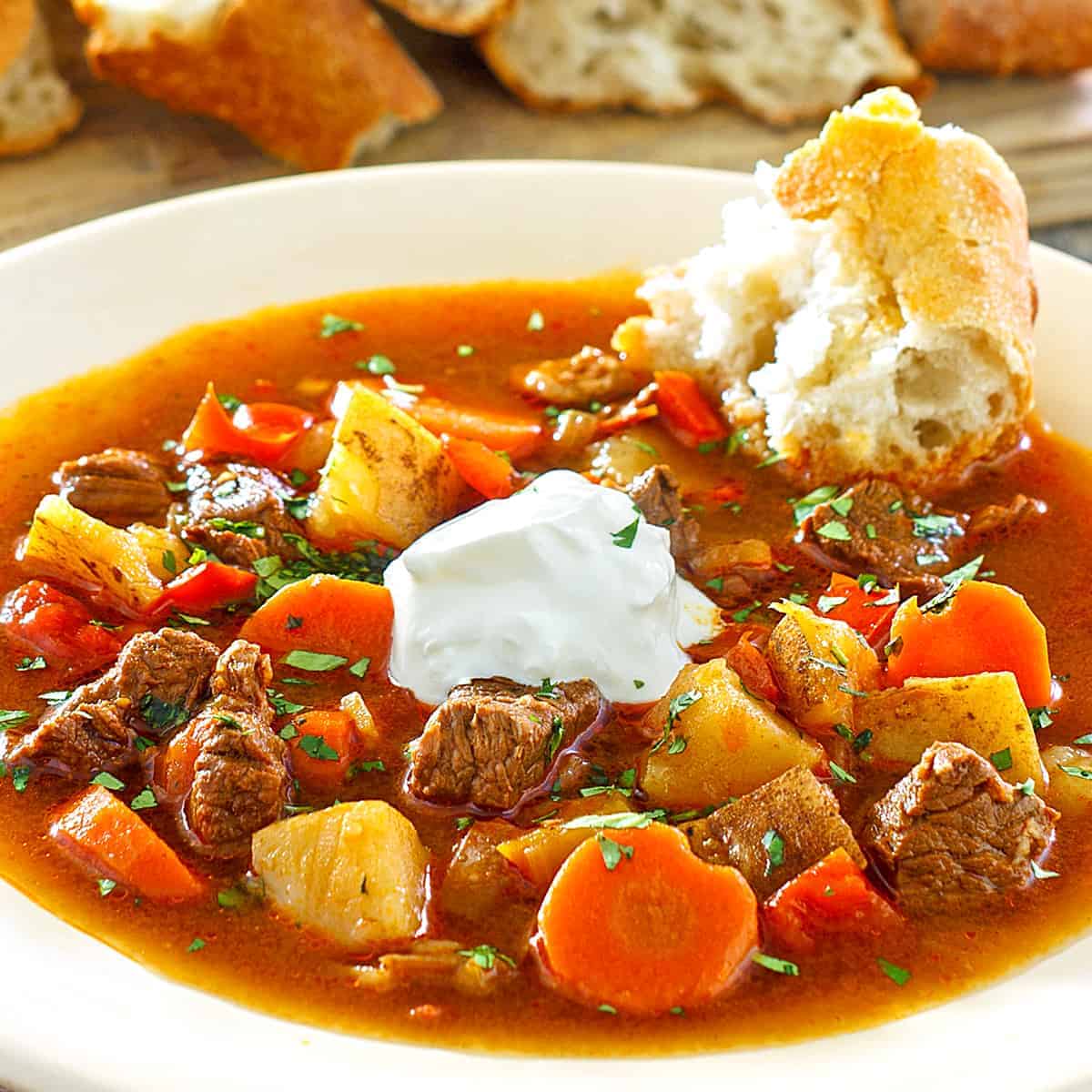
Traditional Hungarian goulash is a prime example of how a few simple ingredients, cooked properly, can yield an incredible flavor. Though many variations of Hungarian goulash exist, and every cook makes it just a bit differently, this is an authentic recipe from the heart of Hungary.
Hungary holds a special place in my heart and in my family’s hearts. My brother lived there for a couple of years and would always describe its beautiful scenery and architecture and his love for the Hungarian people. When I visited Budapest for the first time I immediately fell in love with it. Its name comes from the two sides of the city (Buda and Pest) separated by the Danube River running through it. With its striking chain bridge, stunning parliament building, and its incredible Buda Castle, Budapest is a breathtaking city.


Hungary’s history has been one of hardship and heartbreak. But the passion and stamina of soul has remained in the hearts of the Hungarian people. I’ve always been touched by Hungary’s national anthem, Himnusz, or “hymn”, written by the poet Kölcsey. Their anthem is a poetic prayer and unlike most anthems that focus on an expression of national pride, the Hungarian anthem is a direct, heartfelt plea to God. In the mid-20th century, during the years of strongest communist rule in Hungary, the words were not sung, only the music was played. The communist government asked two of the most acclaimed artists of that time, a poet and composer, to rewrite the national anthem. Both refused. The next communist leader also tried, unsuccessfully, to have it changed. And so Hungary’s national anthem remains Himnusz and its first three lines read:
O God, bless the nation of Hungary
With your grace and bounty
Extend over it your guarding arm

I also love Hungarian food. Their breads and smoked sausages are fantastic as are their meats, stews, sauces, and desserts. Today I’m going to share the national dish of Hungary: Goulash.
What is Hungarian Goulash?
Contrary to popular belief here in the U.S., Hungarian goulash is NOT made with ground beef or macaroni noodles! Traditional Hungarian goulash is an entirely different dish.
Goulash, or as Hungarians call it, gulyás, means “herdsman.” Its origins date back to the 9th century Magyar shepherds as a simple meat and onion stew prepared in heavy iron kettles known as bogracs. In the 15th century invading Ottoman Turks introduced a new spice to Hungary, paprika. While the rest of Europe remained lukewarm towards this red chili pepper from the New World, Hungary embraced it and paprika has since become a defining element of Hungarian cuisine.
Goulash is kind of in between a soup and a stew. Unlike some stews, Goulash is not overly packed full of beef and vegetables, it is a little more brothy. But through the cooking process, the broth becomes a little thicker and very rich in flavor.
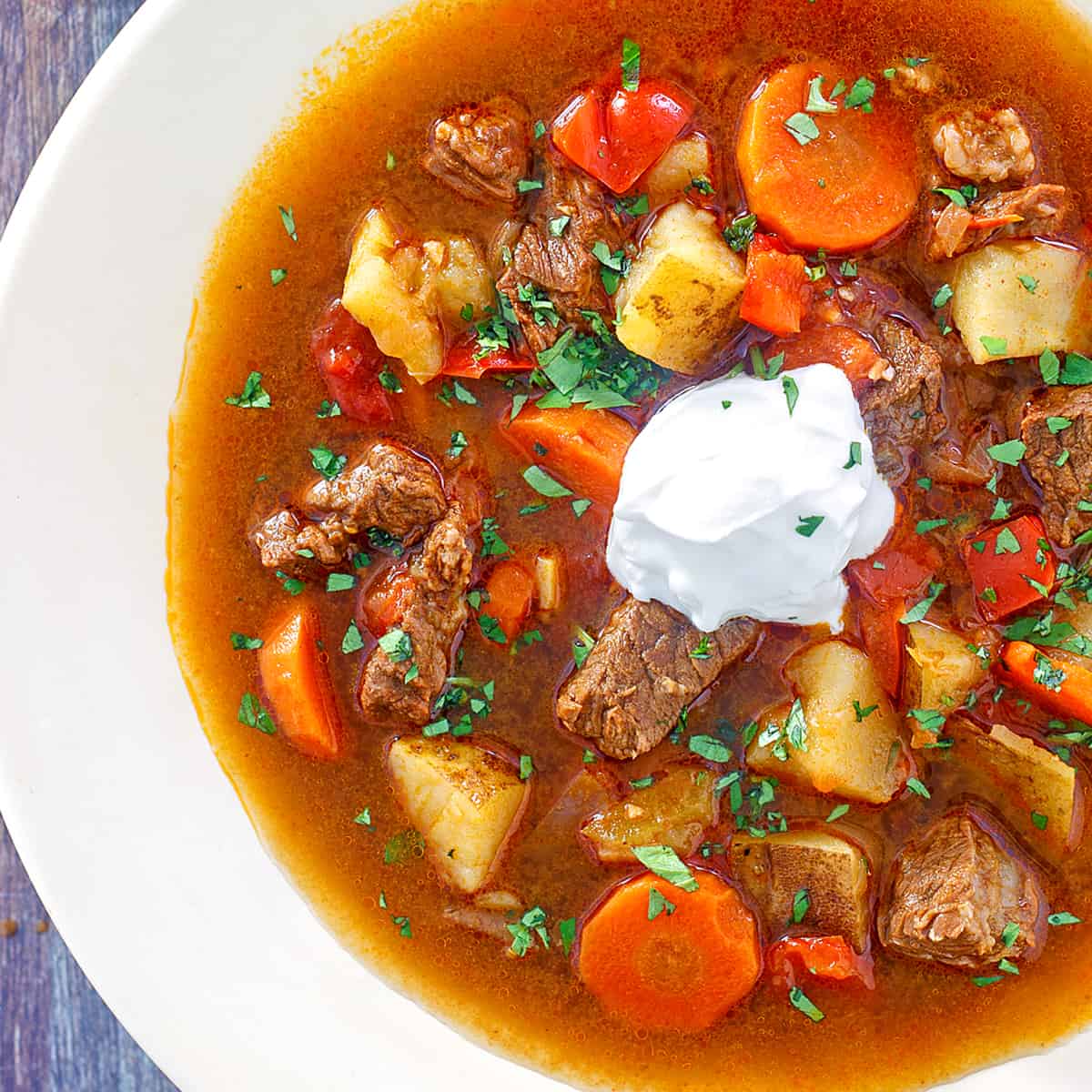
Tips for Authentic Hungarian Goulash
To achieve the ultimate flavor, the cooking method is important and quality, real Hungarian paprika is essential. And lots of it! None of this “2 teaspoons of paprika” jazz. Hungarians use very generous amounts of paprika, and that’s key. A Hungarian once told me, “however much paprika the recipe calls for – at least double or triple it!”
For this size batch of Goulash, you want to use a full 1/4 cup of it. When I lived in Germany, Hungary was just a few hours away and I would stock up on it when I visited. Now I order it online and recommend this genuine imported Hungarian paprika imported from Hungary. There is no comparison in flavor. It has an extraordinarily rich flavor and an exceptionally vibrant red color. Many of our readers have tried it and agree that quality Hungarian-imported paprika makes all the difference.
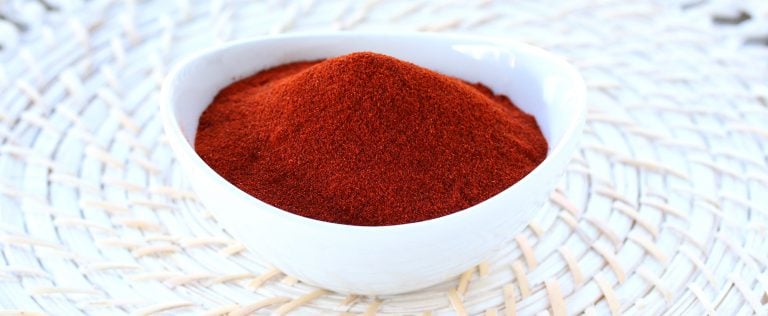
I mentioned earlier, many variations of goulash exist. Some include turnip or wine or caraway seeds, to name a few. But this recipe is a very old, very traditional way of making Goulash that my brother and I learned from older generations of Hungarian women and it needs no embellishments. It’s simple and simply delicious!
What’s the Best Dutch Oven to Use?
For this recipe, I recommend using a Dutch oven because it seals in the flavors and heats evenly, ensuring consistent cooking results. I love this 6-quart, budget-friendly option from Lodge, which you can get on Amazon for around $80. Or, if you’re looking for a worthy splurge, I also have this one from Le Creuset, which sells for around $300.
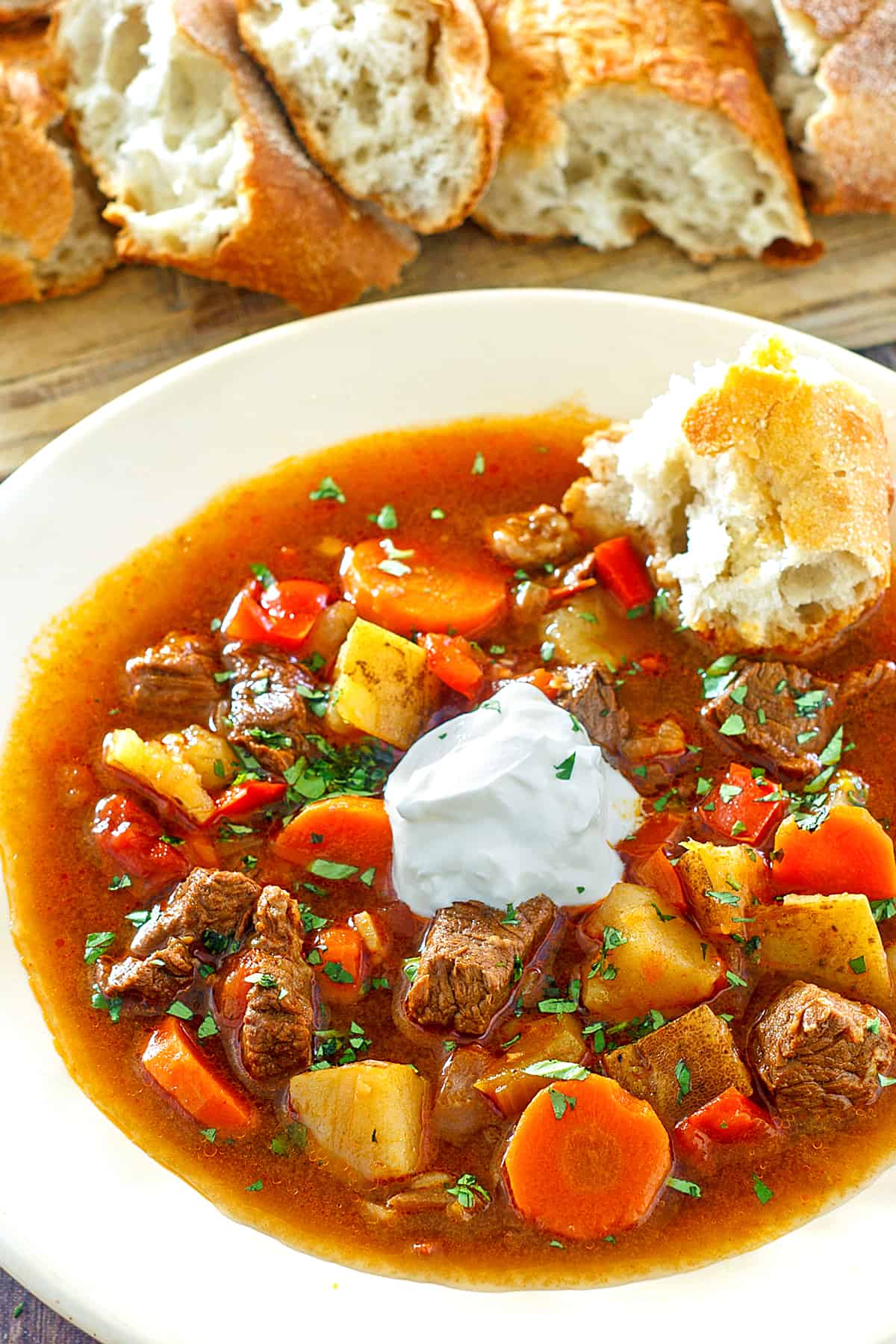
Hungarian Goulash Recipe
Let’s get started!
Melt the lard or butter/oil in a Dutch oven or other heavy soup pot over medium high heat and cook the onions until beginning to brown, about 7-10 minutes. Add the beef and cook until the beef is just starting to brown, 7-10 minutes.
Add the bell peppers, tomatoes, and garlic and cook for another 6-8 minutes. (Note about peppers: Outside of Hungary it’s very difficult to find the peppers they use there. The best ones to use in their place are red and some yellow/orange. Avoid regular green bell peppers as they have a starkly different flavor profile.)
Remove the pot from the heat and stir in the paprika, salt, pepper and caraway (if using) (note: paprika becomes bitter if at all scorched).
Add the beef broth, bay leaf, return to the stove and bring to a boil. Reduce the heat to medium, cover and simmer for 40 minutes. Add the carrots and potatoes. Return to a boil, reduce the heat to medium, cover, and simmer for another 30-40 minutes or until the beef is nice and tender. Add salt to taste. Remove the bay leaf.
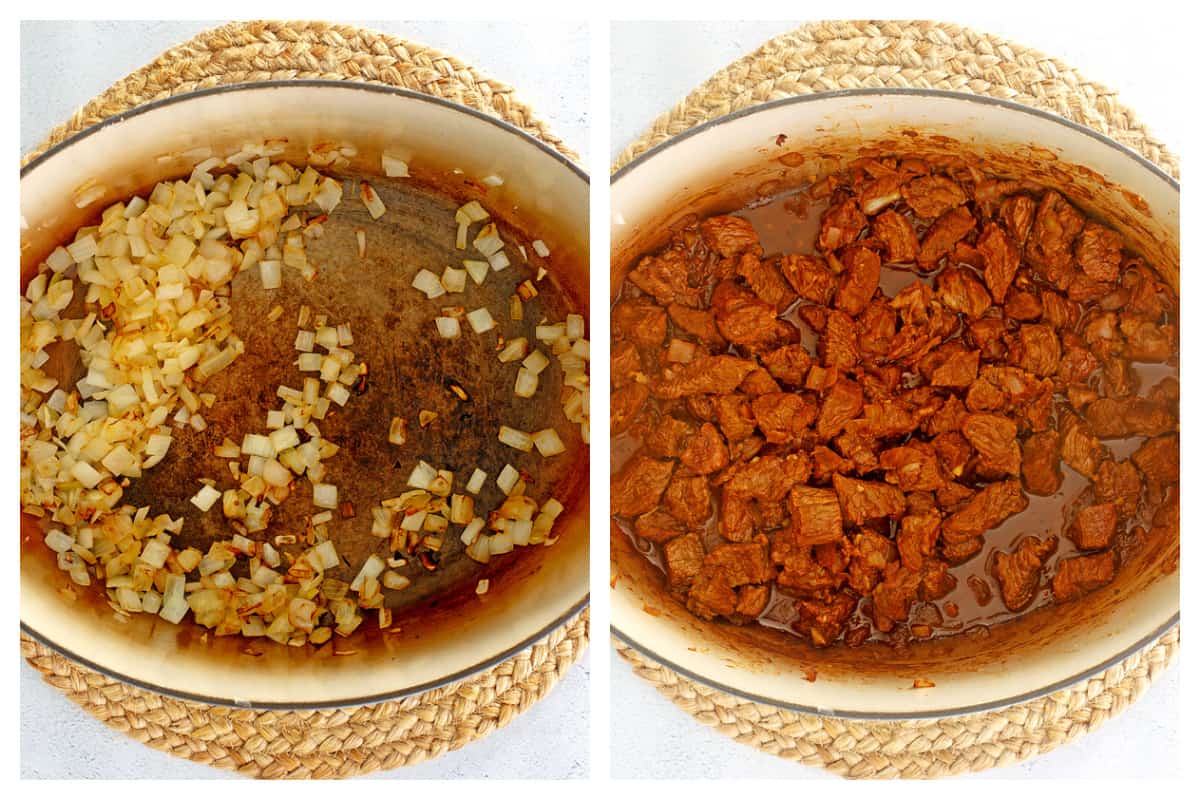
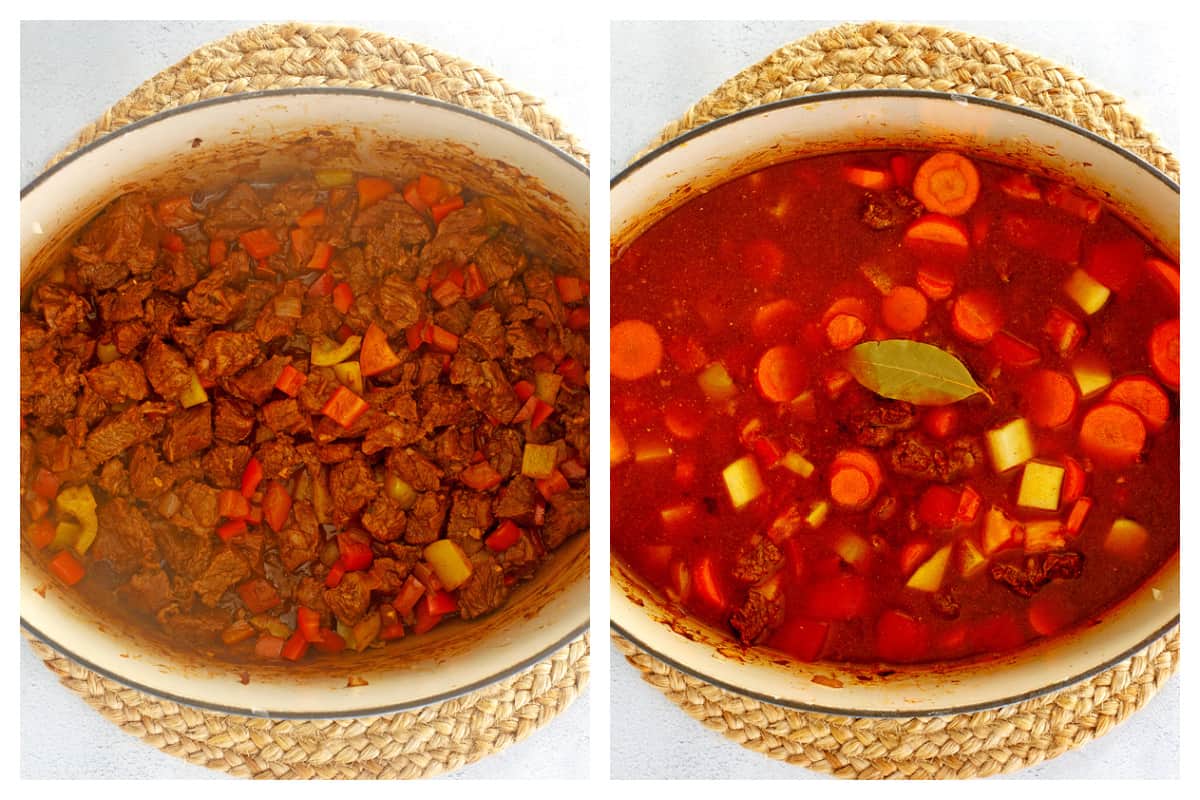
Serve with some crusty bread and, if desired, a dollop of sour cream.
Enjoy!
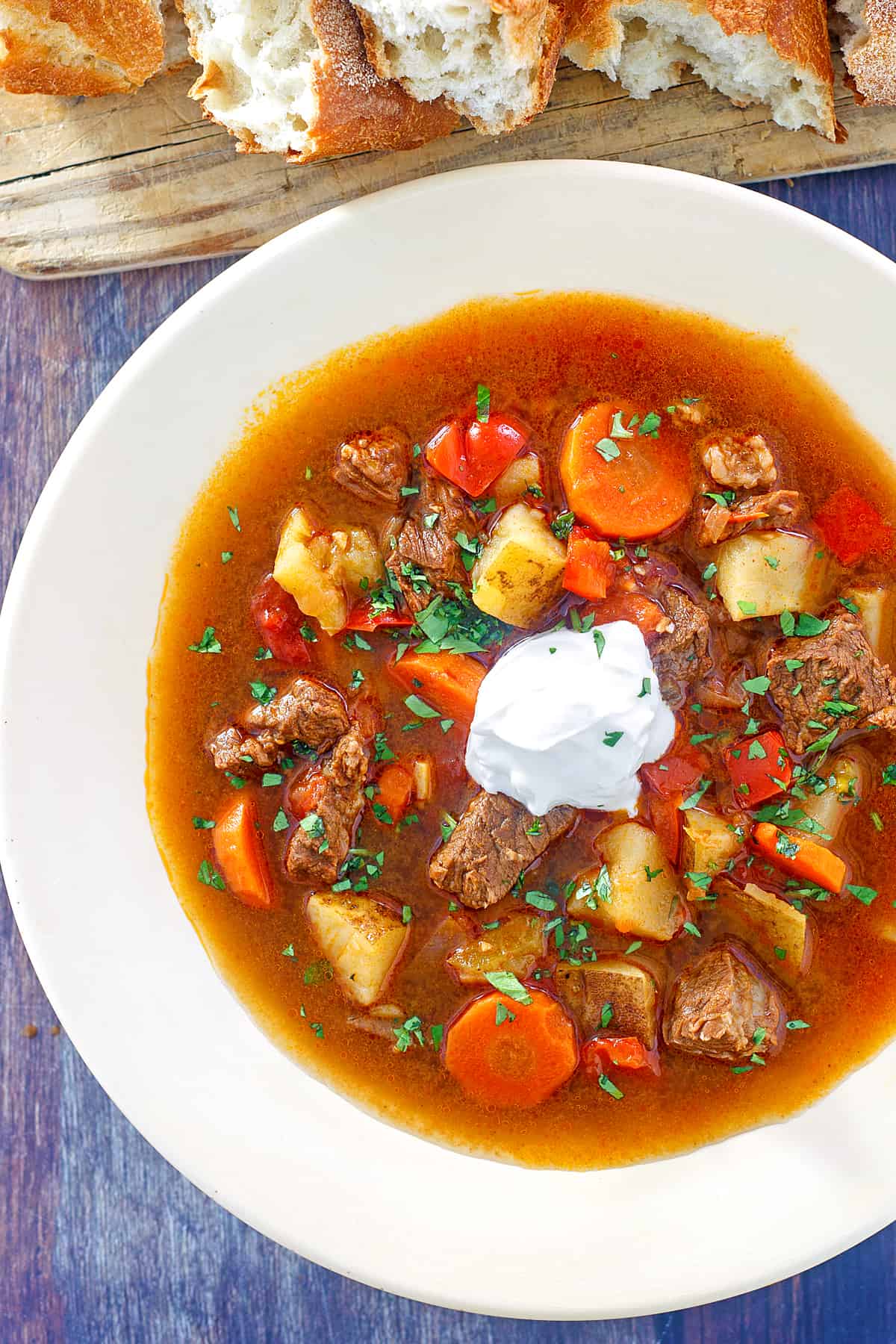
For more authentic Hungarian dishes, be sure to try my:
Save This Recipe
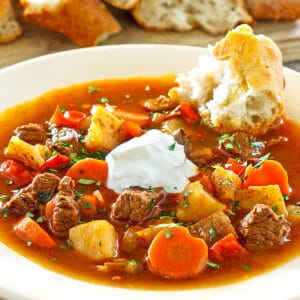
Authentic Hungarian Goulash (Gulyás)
Ingredients
- 3 tablespoons pork lard , or butter or bacon grease (pork lard is traditionally used and imparts a great flavor)
- 1 1/2 pounds yellow onions chopped
- 1/4 cup quality genuine imported Hungarian sweet paprika
- 1 1/2 pounds stewing beef , cut into 1/2 inch pieces
- 5 cloves garlic ,minced
- 2 red bell peppers ,seeded/membranes removed, cut into 1/2 inch chunks
- 1 yellow bell pepper ,seeded/membranes removed, cut into 1/2 inch chunks
- 2 tomatoes ,diced
- 2 carrots ,diced
- 2 medium potatoes ,cut into 1/2 inch chunks
- 5 cups beef broth (traditionally just water is used but beef broth adds so much more flavor)
- 1 bay leaf
- 1 teaspoon salt
- 1/2 teaspoon freshly ground black pepper
- 1/2 teaspoon crushed caraway seeds (optional, not traditional in all regions)
Instructions
- Melt the pork lard or butter/oil in a Dutch oven or other heavy soup pot over medium high heat and cook the onions until beginning to brown, about 7-10 minutes. Add the beef and cook until the beef is just starting to brown, 7-10 minutes. Add the bell peppers, tomatoes, and garlic and cook for another 6-8 minutes. Remove the pot from the heat and stir in the paprika, salt, pepper and caraway (if using) (note: paprika becomes bitter if at all scorched). Add the beef broth, bay leaf, return to the stove and bring to a boil. Reduce the heat to medium, cover and simmer for 40 minutes. Add the carrots and potatoes. Return to a boil, reduce the heat to medium, cover, and simmer for another 30-40 minutes or until the beef is nice and tender. Add salt to taste. Remove the bay leaf.
Nutrition
Originally published on The Daring Gourmet on March 18, 2014
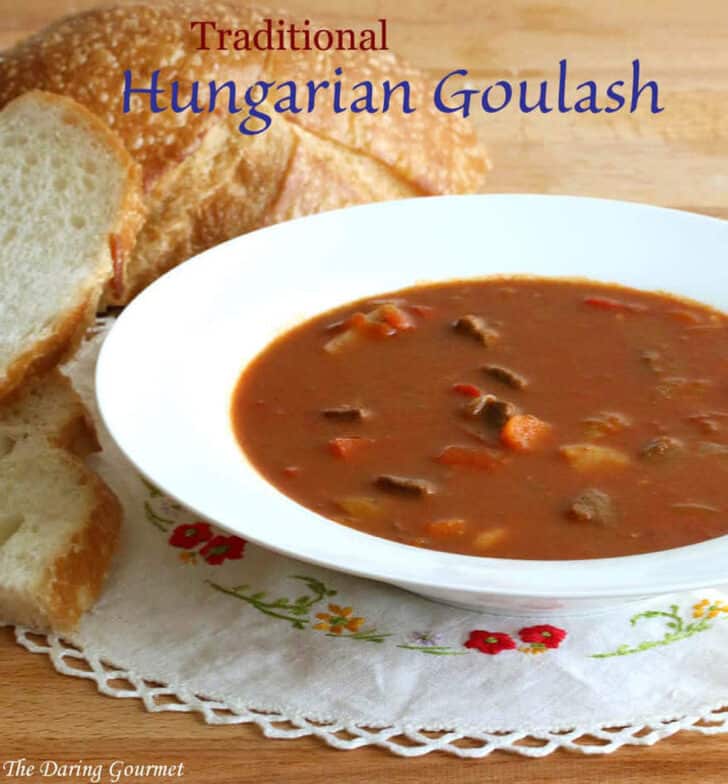



















Made this for dinner this evening, and my wife and I both thought it was great – will definitely make it again. Looking forward to leftovers this weekend (soups and stews always seem to be better a day or two later).
Used all ingredients as listed, except I didn’t like the looks of the tomatoes at the market, so I used canned diced tomatoes. Went a little light on the added salt because there was some salt in the tomatoes.
I agree with Ivel, below, about browning the beef. That much beef, I wanted to brown in two batches. Did that first and removed the meat while I sauteed the onions. Softened the peppers a bit, then added the tomatoes and the browned beef.
That’s wonderful, Gary, I’m so glad you both enjoyed it and I appreciate the feedback, thank you very much!
This was a great recipe! Mine was a bit bland at first so I added about 1.5 teaspoons more salt as well as a bit of cumin and garlic powder. This was a nice easy meal that I’ll definitely be making again when the weather’s colder!
I’m happy you liked it, Joy, and that you were able to adapt it to your taste. Thanks for the feedback!
My mother often said, “The proof of the pudding is in the eating.”
I haven’t made Gulyas yet, but I teach a cooking class at the
apartment building where I live. After the class in July, I will
return to report on how well it was accepted by the Hungarian
who requested Hungarian Gulyas for the class.
I wanted to try something else, I had pork chops instead of beef. I stumbled upon your recipe online, modified the ingredients a bit (no peppers at hand, but potatoes, carrots, celeri, tomato, vidalia onions), veggie cubes for the broth, garlic powder, smoked paprika purchased in Europe, threw it all in the pot more or less per your instructions, added some heat -cayenne pepper and fresh chopped chives at the end, and voilà, after about 90 minutes, my version of your goulash was ready. You gave me the motivation to do it, even though I don’t much like all the prep work (peeling, cutting, chopping). But the result was excellent. Tomorrow leftovers, yummy😋
Fantastic. Only change would be to brown the beef first, then remove and add lard/butter and onions. Add browned beef back with the paprika addition.
Thanks so much for the feedback, Ivel, I’m happy you enjoyed it!
You are adding the tomatos 2 times in cooking describing?
Hi Vladislav, just one time, with the bell peppers.
Simple and straightforward recipe, delicious meal. I recommend everybody to try.
Thank you so much, Vladislav!
Recently been to Europe and visited Hungary and had authentic Hungarian Goulash, I can say that it IS more soup like, absolutely full bodied with delicious flavor! I’m making it today. I came home with Hungarian Sweet Paprika and I can’t wait to try this recipe myself!
This is super delicious and looks exactly like the picture. Next time I would add a little more beef.
Thank you so much, Anita, I’m thrilled that you enjoyed it!
Living in Hungary as I do “gulyás” is on the recipe in every Hungarian restaurant. Unlike what most people believe, guylás is a soup not a stew. This is as authentic a recipe as I’ve seen. It was my first attempt and my Hungarian wife loved it.🥰
Thank you so much for your insights, James, and I’m so thrilled that you enjoyed this!
Beautiful recipe. Thank you. Yummy.
Definitely will be making this again. Delicious!! Served with a loaf of artisan garlic bread and cucumber sour cream salad. I followed the recipe, no changes. When I make it again, I will add more meat than the recipe calls for.
Wonderful! I’m so happy you enjoyed it and I appreciate the positive feedback, thank you Lolo!
Personally I was somewhat disappointed with the taste of this dish. Having prepared pörkölt for the first time a few weeks ago I found this dish rather bland and way too sweet. Well, it is a matter of taste but in the future I will make a few major adjustements to this recipe, such as adding rew wine or red wine vinegar, some chili, way more black pepper and somewhat 2/3 of the broth to make it a stew instead of a soup. The amount of potatoes should also be at least twice the amount.
Hi Kari, what you’re describing isn’t Hungarian goulash :) That said, you are certainly welcome to make any adjustment you like per your taste preferences. If you’re looking for a more stew-like goulash with bolder flavors, I recommend checking out my German goulash recipe (people who have been to Germany often confuse the two, thinking that Hungarian goulash is the same, and it isn’t): https://www.daringgourmet.com/german-goulash-rindergulasch/
Your gulasch is a soup! The amount of liquid is way off!
Hi Kari, Hungarian goulash IS a soup, not a stew. It’s completely different than the goulash you find in Germany and Austria: https://www.daringgourmet.com/german-goulash-rindergulasch/
The amount of liquid is spot on or even a liitle bit to small. Because gulyash IS a soup.
What you think about is pörkölt not gulyash.
This is really good recipe for gulyash.
One remark only; I fry/cook meat until browned first, put it aside and then cook onions because onions clean the pan or pot perfectly (if simmered under the lid for a moment). The rest goes as in the recipe.
Two advises however;
one – use “gulyash cream/paste” mild and hot, produced by hungarian Univer company instead of other paprika pastes or powders because in my experience only this paste gives original and pretty unique taste of gulyash. Maybe I’m wrong but I never succeeded with other types of paprika to get this very characteristic “hungarian” taste.
Two – potatoes in gulyash are correct, but beside or instead of potatoes can be “nokedli” – a kind of small batter dumplings prepared directly in gulash at the end of cooking. Nokedli are very popular addition to gulyash and other soups in Hungarian kitchen.
This was absolutely delicious! It was my first time trying Hungarian Goulash, and I loved the rich flavor of the Hungarian paprika. So glad I found your website—I love exploring new foods and recipes. Thank you!
Thank you, Crumbl, I’m so glad you enjoyed it!
This was incredible and one of the best stews I have ever tasted. I was a little nervous about using that much paprika but I held my breath and dumped it all in. I’m glad I did. A++
I’m so happy you enjoyed it, Rick, thank you very much!
In a bind as no Hungarian paprika or sweet paprika to be found in my neck of the woods (NW MT), and I already bought all the rest of the ingredients. What do you recommend as a substitute (combo paprika, smoked paprika OR?).
Hi Cindy, when you say “combo paprika”, do you mean you have paprika on hand? Paprika that is simply labeled “paprika” is the same thing as sweet paprika, otherwise it will specify “hot” or “smoked”. You definitely do not want to use smoked paprika in this. And using that much hot paprika will likewise ruin the dish. If you have something that’s labeled simply “paprika” then I would use that, even if it’s Spanish paprika.